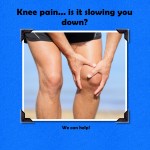Knee pain… is it slowing you down?

There are two types of knee pain; temporary, which would be a recent accident or injury, or chronic knee pain which is often a culmination of different factors or old untreated injuries.
Typical causes of knee pain can include:
- Torn ligaments caused by trauma
- Hyperextension
- Tears in cartilage
- Dislocated knee cap
- Tendinitis
- Loose cartilage brought on by trauma
- Arthritis
- Irritation of the bursa caused by overuse
What are the symptoms of chronic knee pain?
The symptoms of chronic knee pain are different for each person, and the cause for the knee pain often affects how the pain feels. Chronic knee pain may present as a:
- Pain while bending or straightening
- Stiffness
- Difficulty bearing weight – like walking/standing
- constant ache
- sharp, shooting pain when in use
- dull burning discomfort
- clicking/grinding sounds with movement and accompanied by pain
You may also experience chronic swelling and pain when the knee is touched.
Factors that make knee pain worse:
- injuries to the structure of the knee can cause bleeding and swelling and can create a chronic problem over time if not treated properly
- sprains and strains
- overuse
- infection
- bad posture and form when doing physical activity
- not warming up or cooling down before or after physical activity
- improperly stretching the muscles
- tight and/or weak muscles
Who is at risk for chronic knee pain?
People who are overweight or obese are at a greater risk for knee problems. For every pound that you are overweight, your knee must absorb an extra 4 pounds of pressure when you walk, run, or climb stairs.
Other factors that increase your risk for chronic knee pain include:
- age
- previous injuries or trauma
- athletic activity or physical exercise
How can chronic knee pain be reduced or prevented?
You can prevent some, but not all, of the possible causes of knee pain. Things you can do to alleviate some of the pain can include:
- Warm up before exercise. Stretch your quadriceps and hamstrings before and after exercise.
- Try low-impact exercises. Instead of tennis or running, give swimming or biking a chance. Mix low-impact exercises with high-impact exercises to give your knees a break.
- Lose weight.
- Walk down hills. Running puts extra force on your knee. Instead of running down an incline, walk.
- Stick to paved surfaces. Rough roads or pocked walkways may be hazardous to your knee’s health. Stick to smooth, paved surfaces like a track or walking arena.
- Get support. Shoe inserts can help treat foot or gait problems that may be contributing to knee pain.
- Replace your running shoes frequently to ensure they still have proper support and cushioning.
Our knee is a complex joint and is susceptible to a number of injuries and conditions. If you experience knee pain, new or old, book a first assessment with our Physical therapist today. A doctor’s referral is not required.
